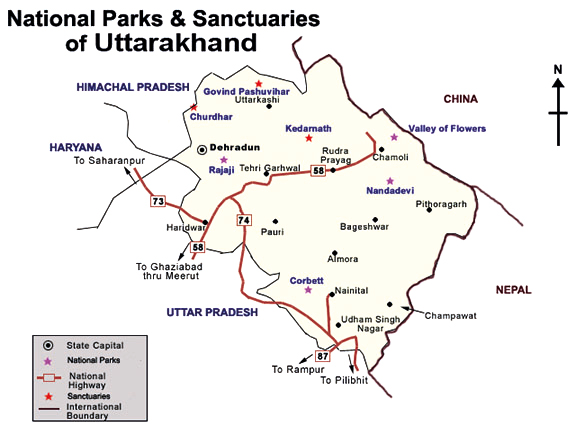Uttarakhand Switch to Hindi
Stray Dogs Near Corbett Tiger Reserve to be Vaccinated
Why in News?
According to the sources, Stray dogs in villages within 2 kilometre radius of the Corbett Tiger Reserve's boundaries in Uttarakhand will be vaccinated against the canine distemper virus so that the disease does not infect tigers and elephants of the reserve.
Key Points
- Canine distemper is a contagious and serious disease that attacks the respiratory, gastrointestinal and nervous systems of dogs.
- The vaccination drive will be conducted as part of a central government funded pilot project for better health of wildlife.
- It is a project of the National Mission for Himalayan Studies of the Government of India, aims to work on ways to improve the health of the country's wildlife.
- The Veterinary Department of Uttarakhand government and Indian Veterinary Research Institute (IVRI) located in Uttar Pradesh's Bareilly will jointly examine and vaccinate stray dogs.
Canine Distemper Virus
- Canine distemper virus is known mainly to cause a severe infection in dogs and wild carnivores such as wolves, foxes, raccoons, red pandas, ferrets, hyenas, tigers, and lions.
- The prevalence of this virus and its diversity in wildlife of India is not adequately studied.
- A lion does not eat the entire prey at one go. In between, the dogs consume the kill and infect it with the CDV. Once the lion returns to finish it off, it gets the deadly disease.
- The CDV is more dangerous for lions than tigers. This is because lions move together in large numbers, making them more vulnerable to the virus as compared to tigers that are more isolated and territorial animals.
Uttarakhand Switch to Hindi
World Elephant Day
Why in News?
Recently, The Corbett Tiger Reserve in Uttarakhand ran an awareness campaign to celebrate World Elephant Day.
Key Points
- Corbett Tiger Reserve
- It is located in the Nainital district of Uttarakhand. The Project Tiger was launched in 1973 in Corbett National Park (first National Park of India), which is part of Corbett Tiger Reserve.
- The national park was established in 1936 as Hailey National Park to protect the endangered Bengal tiger.
- It is named after Jim Corbett who played a key role in its establishment.
- The core area forms the Corbett National Park while the buffer contains reserve forests as well as the Sonanadi Wildlife Sanctuary.
- The entire area of the reserve is mountainous and falls in the Shivalik and Outer Himalaya geological provinces.
- Ramganga, Sonanadi, Mandal, Palain and Kosi are the major rivers flowing through the Reserve.
- Sprawling over 500 square kilometres, CTR is home to 230 tigers and has the world’s highest tiger density at 14 tigers per hundred square kilometres.
- Flora:
- Dense moist deciduous forests are found. According to the botanical survey of India, Corbett has 600 species of plants - trees, shrubs, ferns, grass, climbers, herbs, and bamboo. Sal, Khair, and Sissoo are the most visible trees found in Corbett.
- Fauna:
- Apart from tigers, Corbett also has leopards. Other mammals such as jungle cats, barking deer, spotted deer, sambar deer, sloth etc. are also found there.
- Other Major Protected Areas of Uttarakhand:
- Valley of Flowers National Park.
- Valley of Flowers National Park and Nanda Devi National Park together are a UNESCO World Heritage Site.
- Rajaji National Park.
- Govind National Park
- It is located in the Nainital district of Uttarakhand. The Project Tiger was launched in 1973 in Corbett National Park (first National Park of India), which is part of Corbett Tiger Reserve.
World Elephant Day
- It is celebrated every year on the 12th August to bring awareness to the status of Asian and African elephants in the wild.
- The theme for 2024 is “Personifying prehistoric beauty, theological relevance, and environmental importance”.
- India is home to about 60% of the world's Asian elephant population, with an estimated 27,312 individuals as per the 2017 census and 138 identified elephant corridors.
- Elephants have a gestation period of about 22 months, the longest of any land animal.
- Asian elephants (Indian) are classified as Endangered on the IUCN Red List due to habitat loss, human-elephant conflict, and poaching.
Bihar Switch to Hindi
Gurmar Found on Gaya’s Brahmayoni Hill
Why in News?
Recently, A team of researchers has uncovered an array of medicinal plants at Brahmayoni Hill in Gaya, Bihar, with Gymnema sylvestre (commonly known as Gurmar) being one of the notable findings that is known as anti-diabetic herb.
Key Points
- The Council of Scientific and Industrial Research (CSIR) has already utilized this medicinal herb in developing the anti-diabetic drug BGR-34.
- Gurmar is known for its unique ability to reduce blood sugar levels due to the presence of gymnemic acid which works by occupying receptor sites in the outer lining of the intestine, thereby curbing cravings for sweetness.
- As a result, the intestine absorbs fewer sugar molecules, which results in low blood sugar levels.
- In addition, the plant contains flavonoids and saponins, which help regulate lipid metabolism.
Council of Scientific and Industrial Research (CSIR)
- CSIR is the largest research and development (R&D) organisation in India. CSIR has a pan-India presence and has a dynamic network of 37 national laboratories, 39 outreach centres, 3 Innovation Complexes and 5 units.
- Established: September 1942
- Headquarters: New Delhi
- CSIR is funded by the Ministry of Science and Technology and it operates as an autonomous body through the Societies Registration Act, 1860.
- CSIR covers a wide spectrum of streams – from radio and space physics, oceanography, geophysics, chemicals, drugs, genomics, biotechnology and nanotechnology to mining, aeronautics, instrumentation, environmental engineering and information technology.
- It provides significant technological intervention in many areas with regard to societal efforts which include the environment, health, drinking water, food, housing, energy, and farm and non-farm sectors.

.gif)

.png)
















.png)


.jpg)



 PCS Parikshan
PCS Parikshan



